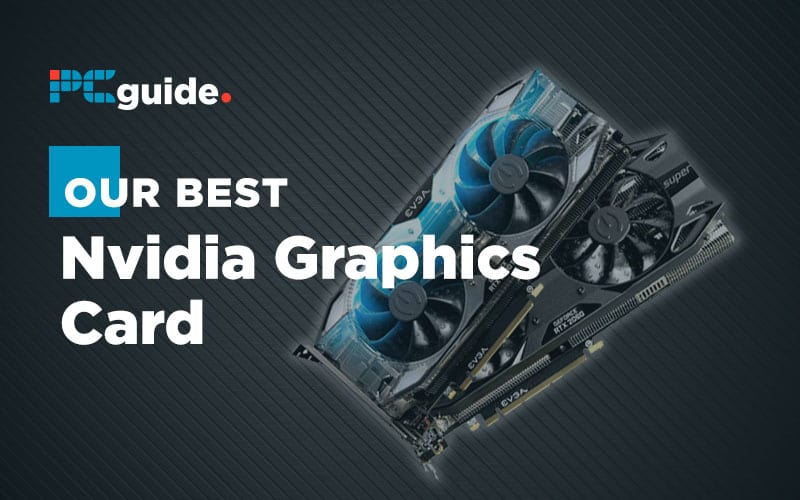Today, we’re going to examine Nvidia’s current line of 16- Series and 20- Series GPUs in order to find the best Nvidia graphics card. We’ll be picking our top selection for a given card based on price-to-performance and availability, and where we’ve written longer guides for various versions of the card, we’ll link to them.
Each card will be covered in detail. Whether you’re a complete novice or a GPU enthusiast, we believe this article will give you all the information you need to know in order to make an informed purchasing decision.
If you’re more interested in AMD’s current lineup, click here to check that one out.
…but for now, let’s jump in!
Table of Contents
EVGA GTX 1660 Super SC Ultra
The best budget Nvidia GPU
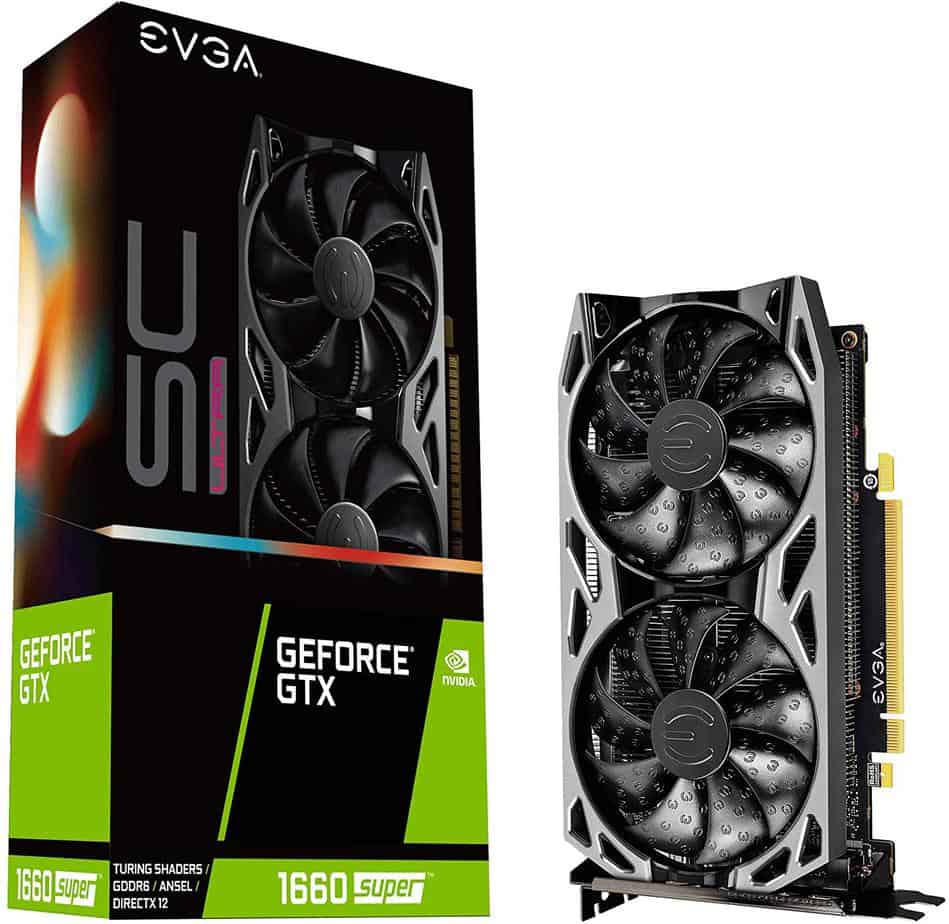
- Clock Speed: Up to 1830 MHz
- VRAM: 6GB GDDR6
- Width: 2-Slot
- Length: 203 mm
- Ports: 1 HDMI, 1 DP, 1 DVI
- Power Recommendation: 450 Watts
- Succeeds the GTX 1660 at roughly the same price point
- Cheaper than the competing RX 5600 XT and GTX 1660 Ti while providing most of the same performance (and no VBIOs issues)
- For this specific card, able to fit into your average system with little issue
- For this specific card, has a healthy factory overclock
The Nvidia GTX 1660 Super is the successor to the GTX 1660, and is priced between the 1660 and its Ti counterpart in Nvidia’s lineup. It is Nvidia’s premier budget GPU option, and is designed to compete with much more expensive cards from both AMD and Nvidia themselves.
How does it perform?
The 1660 Super outperforms the original 1660 and comes within spitting range of the more-expensive 1660 Ti despite being much less expensive. This is an example of Nvidia competing with itself, but that’s fairly common from both GPU manufacturers in this price range.
For a bit under $250, you get a graphics card that outperforms the Xbox One X. (The Xbox One X and PS4 Pro both use upscaling from lower resolutions to achieve 4K, and often use the PC equivalent to medium settings as well.) This makes it an outright overpowered pick for 1080p gaming, and also surprisingly well-equipped for 1440p gaming.
4K gaming can be achieved with settings tweaks or with a similar workaround as the consoles, by running at 1800p instead of full 4K. On a 27-inch 4K monitor at average viewing distance, the difference between 1800p and a native 4K image is almost imperceptible but comes with a great boost to performance.
This particular GTX 1660 Super from EVGA is one of the most well-priced and fully-featured picks available, so we opted for it over other 1660 Supers. If you want to check out what other manufacturers have to offer with this GPU, check our other roundup, linked below.
Click here for detailed benchmarks from Digital Foundry.
Ideal for what resolutions, frame rates, and settings?
Note: Some games, especially eSports titles, are much lighter than other modern games and can generally be pushed farther than these targets.
- 1080p & 100+ FPS at High/Max Settings in modern games
- 1080p & 140+ FPS at Medium/High Settings in modern games
- 1440p & 100+ FPS at Medium/High Settings in modern games
- 1800p & 60+ FPS at Medium/High Settings in modern games
Want to see our other top GTX 1660 Super picks? Click here!
EVGA RTX 2060 Super SC Ultra
The best value Nvidia GPU
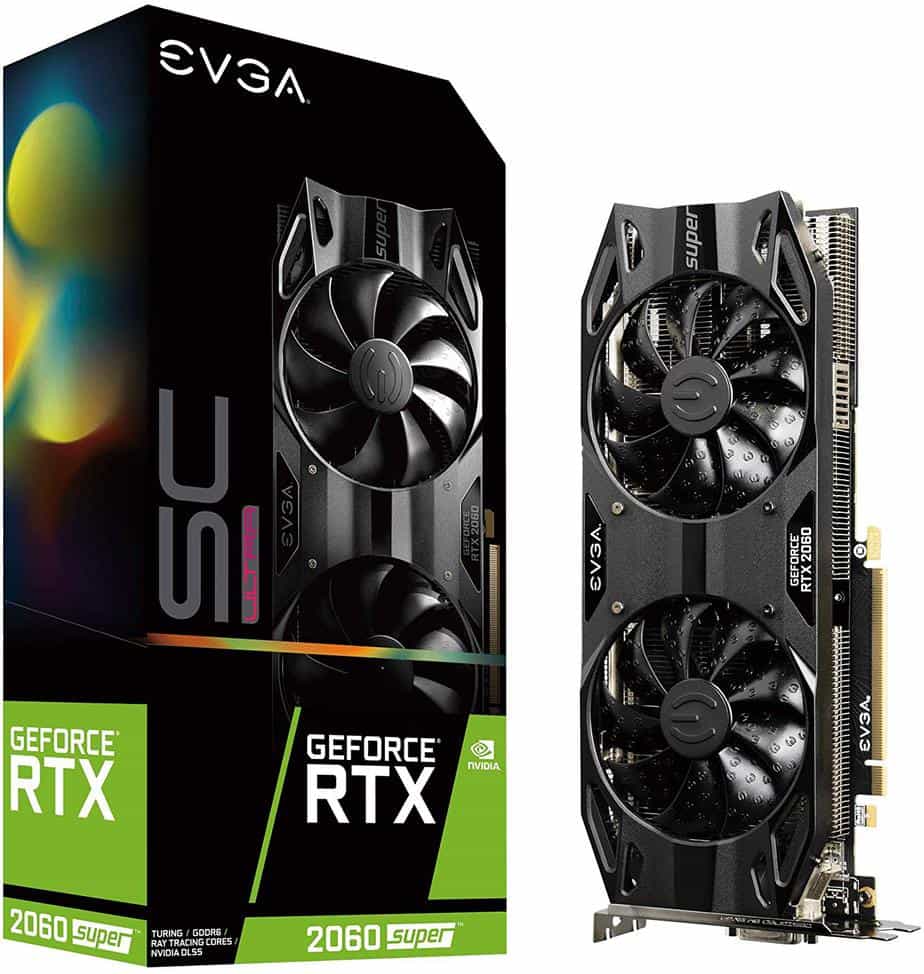
- Clock Speed: Up to 1680 MHz
- VRAM: 8GB GDDR6
- Width: 2-Slot
- Length: 270 mm
- Ports: 2 DP, 1 HDMI, 1 DVI
- Power Recommendation: 550 Watts
- For only a bit more than an RTX 2060, offers performance on par with the original RTX 2070
- Enables real-time ray-tracing, a feature AMD can’t offer in this price range
- Great overall performance
- For this specific card, might be a little long for some systems
The RTX 2060 Super is the successor to the first-gen RTX 2060, but unlike the 2070 S and 2080 S, does not replace its non-Super counterpart. In fact, it’s a little more expensive than that one.
In return for paying that higher price, though, you get a whopping 20 percent performance improvement over the non-Super 2060. That performance puts it on par with the original RTX 2070, which is an impressive feat for any graphics card in this price range.
Also, it offers real-time ray-tracing! This feature will become more important in the coming years, since both the Playstation 5 and Xbox Series X have built-in ray-tracing capabilities. While modern games aren’t using it much yet, this is a great way to future-proof your GPU purchase a little bit.
This specific RTX 2060 Super is a little long for some systems, but we chose it for its great pricing and performance compared to other options. If you want a shorter 2060 Super, or just want to see other options, click the link to our larger roundup below.
How does it perform?
To be more specific about performance, you can expect a lot from this card.
1080p and VR gaming are no sweat for this card. Pushing 140+ FPS in 1080p and 100+ FPS in VR shouldn’t be an issue at all for the 2060 Super. Even with the most intensive modern games, you’d be hard-pressed to bring this card to its knees at 1080p.
In 1440p, this card performs well at high-to-max settings and 60+ FPS. If you’re using a high-refresh monitor, only minor settings adjustments should be required to reach 100+ FPS.
At native 4K, this card is definitely being pushed to its limits. In the most intensive games, expect to be pushed to 30 FPS or lower. Use scaling from a lower resolution, like 1800p, or lower your settings in order to achieve higher frame rates.
Click here for detailed benchmarks from Digital Foundry.
Ideal for what resolutions, frame rates, and settings?
Note: Some games, especially eSports titles, are much lighter than other modern games and can generally be pushed farther than these targets.
- 1080p & 140+ FPS at Max Settings in modern games
- 1440p & 100+ FPS at High/Max Settings in modern games
- 1800p & 60+ FPS at High/Max Settings in modern games
- Native 4K & 30+ FPS at Medium/High Settings in modern games
Gigabyte RTX 2070 Super Windforce OC
The best mid-range Nvidia GPU
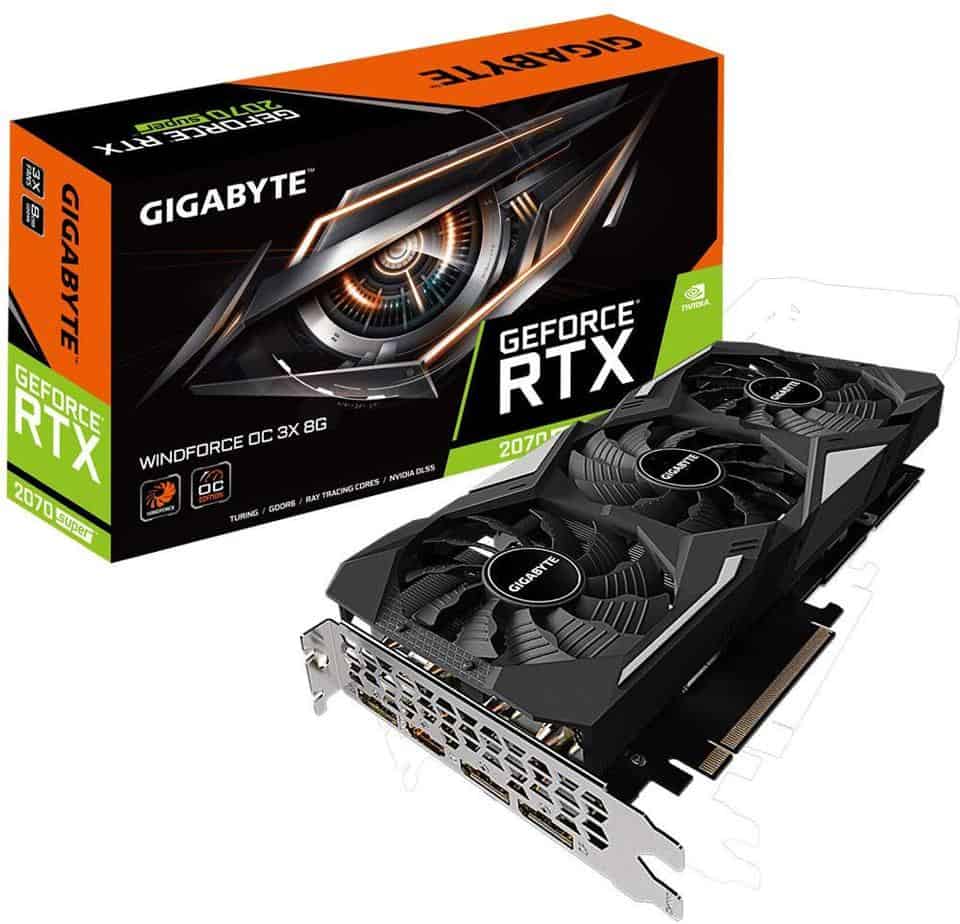
- Clock Speed: Up to 1785 MHz
- VRAM: 8GB GDDR6
- Width: 2.2-Slot (Cooler Slightly Protrudes)
- Length: 281 mm
- Ports: 3 DP, 1 HDMI, 1 USB-C
- Power Recommendation: 650 Watts
- Replaces the RTX 2070 at the same price point, but with a ~10% performance boost
- Offers a decent non-RT performance boost over the 2060 S and a much larger RT performance boost
- Offers ray-tracing, which AMD does not in this price range
- For this card specifically, offers the best cooling of any RTX 2070 Super
The Nvidia RTX 2070 Super replaces the non-Super 2070 at the same price point. Since the previous card is no longer being manufactured, the 2070 S completely replaces the previous card. While the 2080 Super also does this, other Super cards do not phase out their non-Super counterparts, much to the confusion of retailers and consumers everywhere.
The 2070 Super isn’t a massive leap over its non-Super version like the 2060 Super is, but it still offers some decent performance improvements. When put to the test head-to-head by TechRadar, the performance difference between the two was found to be quite marginal. While this is unfortunate, it doesn’t make the card invalid.
This is still a fairly strong option for its price. Let’s talk about why.
How does it perform?
In 1080p and VR, don’t even worry. You are extremely overspecced for gaming at 1080p, and the only limit to your framerate at this point should be your CPU. VR is a bit more demanding than 1080p, but the story remains the same: reaching the 90-to-120 Hz maximum in VR headset resolutions shouldn’t be an issue. In the few titles where it might be, a little bit of resolution scaling should fix the problem fairly easily.
In 1440p, you’re equipped for high-to-max settings and 120+ FPS in all but the most extremely unoptimized games. (Lookin’ at you, AC Odyssey.) While next-gen games in the coming years may put the card under more stress, we’d be shocked if the next-gen consoles actually outperform this GPU.
In native 4K, you’ll start to notice some strain. You can reach 40+ FPS at high-to-max settings, but 30 FPS is still possible for some games, like ones that rhyme with “Assassin’s Creed Odyssey”. In order to alleviate this, lower your settings or play at 1800p instead, which performs better but looks virtually the same to most users.
Click here for detailed benchmarks from Digital Foundry.
Ideal for what resolutions, framerates, and settings?
Note: Some games, especially eSports titles, are much lighter than other modern games and can generally be pushed farther than these targets.
- 1080p & 200+ FPS at Max Settings in modern games
- 1440p & 120+ FPS at High-to-Max Settings in modern games
- 1800p & 60+ FPS at High-to-Max Settings in modern games
- Native 4K & 30+ FPS at High-to-Max in modern games, lower settings for 40+ FPS
EVGA RTX 2080 Super XC Ultra
The best high-end Nvidia GPU
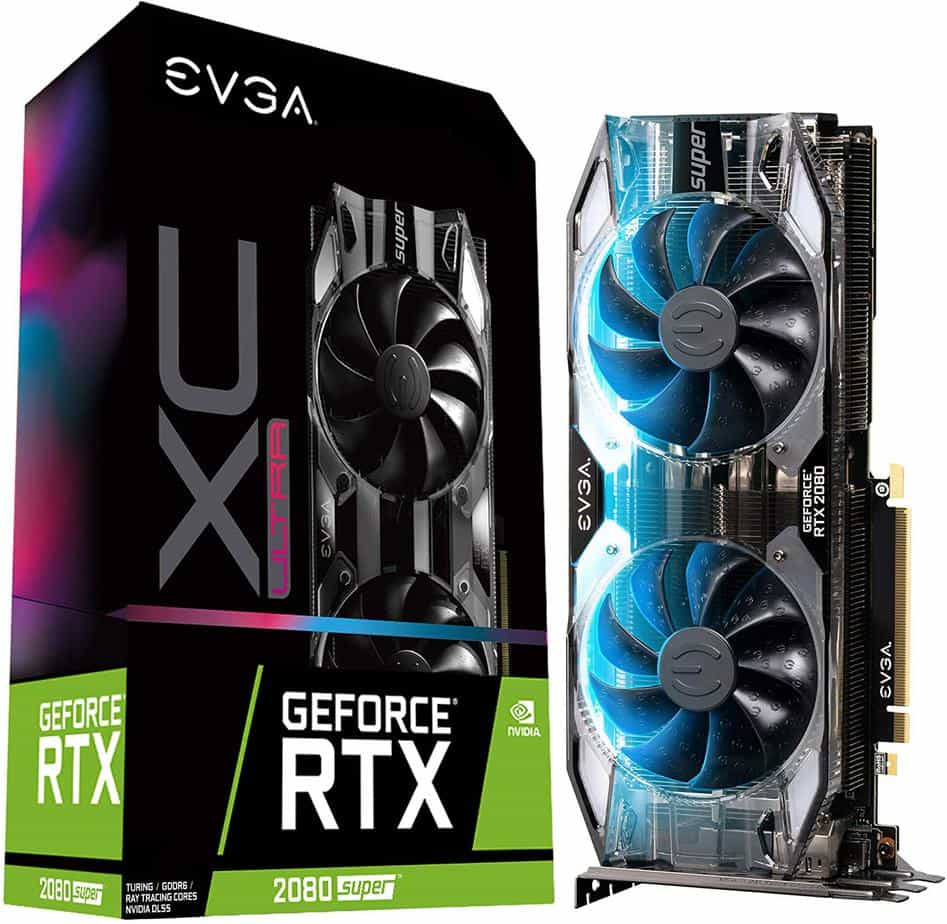
- Clock Speed: Up to 1855 MHz
- VRAM: 8GB GDDR6
- Width: 3-Slot
- Length: 267 mm
- Ports: 3 DP, 1 HDMI, 1 USB-C
- Power Recommendation: 650 Watts
- Offers a level of performance beyond any AMD card currently available on the market (Feb 2020)
- Compares favorably to the MUCH more expensive RTX 2080 Ti
- Has superb ray-tracing performance
- This card, in particular, offers a great OC and RGB
The RTX 2080 Super is the successor to the RTX 2080, and boasts a decent 10% performance improvement over the card it’s replacing at the same price. While this is hardly a generational leap, such an improvement for a refresh is to be expected, and it’s still a fairly strong card for the price point. Like with the 2070 Super, the 2080 Super has completely replaced its non-Super counterpart in manufacturing and circulation, though a few used or refurbished 2080s may still be laying around somewhere.
Compared to other RTX 2080 Supers, the particular model that we’ve chosen from EVGA is actually a very compelling pick. In addition to the flashy RGB on its cooler, it’s also less expensive than many other 2080 Supers on the market. Add these factors alongside its beefy cooler and stellar factory overclock, and we’re hard-pressed to complain about the card.
This EVGA version probably won’t fit in your ITX system, though. For other picks, especially ones with more reasonable sizes, scroll down to check out our RTX 2080 Super roundup, which includes other 2080 Supers for you to choose from.
How does it perform?
In terms of raw performance, you’re being extremely well taken care of.
1080p performance won’t really change here, compared to the 2070 Super, because you’re already going to hit a CPU bottleneck in virtually every game. VR titles should be a breeze, too, even at 120 Hz.
1440p is also easily pushed to 140+ FPS on this card, even at high and max settings. Even with ray-tracing enabled, you can still maintain 60+ FPS at 1440p in all but the most extreme scenarios.
Native 4K is within the reach of this card, able to comfortably play at 60+ FPS and maximum settings in just about every game on the market. Use 1800p and resolution scaling and you may even be able to take that above 100+ FPS.
If you’re buying this card for high-resolution gaming, be sure to turn down extraneous settings like AA before anything else. Other settings will vary on a case-by-case basis, but at 4K, it’s fair to lower to 1800p or enable resolution scaling in order to keep performance at acceptable levels.
Click here for detailed benchmarks of this card, from Digital Foundry.
Ideal for what resolutions, frame rates, and settings?
Note: Some games, especially eSports titles, are much lighter than other modern games and can generally be pushed farther than these targets.
- 1080p & 240+ FPS at maximum settings in modern games
- 1440p & 120+ FPS at maximum settings in modern games
- 1800p & 100+ FPS at high-to-max settings in modern games
- Native 4K & 60+ FPS at high-to-max settings in modern games
EVGA RTX 2080 Ti XC Ultra
The best overall Nvidia GPU
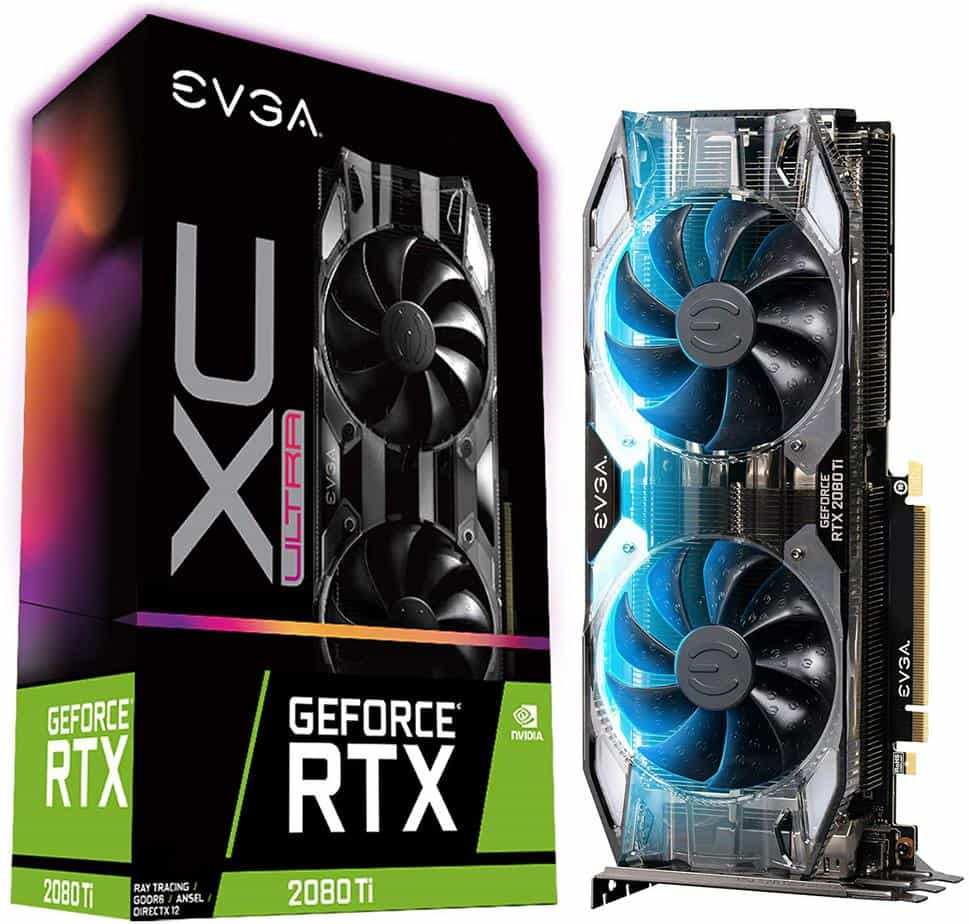
Clock Speed: Up to 1650 MHz
VRAM: 11GB GDDR6
Width: 3-Slot
Length: 270 mm
Ports: 3 DP, 1 HDMI, 1 USB-C
Power Recommendation: 650 Watts
- Offers the best graphics performance on the market, period
- Offers the best ray-tracing performance on the market, period
- Comes with plenty of extras, like RGB
- For this card in particular, is much cheaper than many other 2080 Tis that perform exactly the same
Last but certainly not least, let’s talk about the RTX 2080 Ti. This card did not receive a Super refresh with the rest of its brethren, and we’d wager that it’s very unlikely to.
For a while now, Nvidia has held a kind of monopoly in the ultra-high-performance GPU market. While that may change in the near future with AMD and Intel bringing hot new graphics architectures, the RTX 2080 Ti is the uncontested most powerful GPU on the market at the time of writing. This card is, no exaggeration, the most powerful graphics card of all time.
It’s also...a little bit overpriced for what it offers. Even at MSRP, the performance gains over the RTX 2080 Super aren’t particularly massive. For a nearly 50 percent price increase over the RTX 2080 Super, you only get a roughly 30 percent performance increase. While that still elevates this card much higher than any other consumer graphics card, it’s still a lot of money to ask for.
This card is not for consumers who want the best bang for their buck. It’s for people who can afford the diminishing returns for the ultra high-end, or those who just want to flex.
Even with those points in mind, though, we were still discerning when searching for an RTX 2080 Ti. The price discrepancy between some models of this GPU can be measured in hundreds of dollars, but for this article, we stuck with something much closer to MSRP. That ended up being the EVGA XC Ultra RTX 2080 Ti, despite all of the fancy extras that card has to offer.
How does it perform?
This card utterly stomps 1080p and VR. At this point, any performance issues could literally only be your graphics card.
For 1440p, pushing max settings to 140+ FPS should be a breeze in every game that isn’t named “Odyssey”. 100+ FPS at 1800p should be fairly achievable, too.
For native 4K, this is the best performer by far. Even at maximum settings, Crysis 3 at 4K still can’t manage to push this card below a high-60 FPS average. Add just a little bit of optimization to your 4K gaming and expect to push 100+ FPS with ease.
Want to see some detailed benchmarks? Click here to see Digital Foundry’s.
Ideal for what resolutions, frame rates, and settings?
Note: Some games, especially eSports titles, are much lighter than other modern games and can generally be pushed farther than these targets.
- 1080p & 240+ FPS at Maximum Settings in modern games
- 1440p & 140+ FPS at Maximum Settings in modern games
- 1800p & 100+ FPS at Maximum Settings in modern games
- Native 4K & 60+ FPS at Maximum Settings in modern games
Choosing the right Nvidia GPU for your system
We covered performance on a per-card basis above, but there are a few things still worth discussing that apply to all of them. Most namely…
Width
Width counts the number of PCI slots taken up on your motherboard and chassis by the installation of your graphics card. This one won’t generally be a concern, especially for users who only use PCIe slots for their GPU, but it can be an issue if you are running multiple expansion cards. It can also be problematic for those building in very space-constrained Mini ITX or HTPC builds, so we’re sure to include it here.
Length
Length, measured in millimeters, refers to the longest side of the graphics card. This is the most likely barrier to installation in most systems, especially Mini ITX or Micro ATX systems. We’ve kept this vital spec front-and-center so that you can tell, at a glance, whether or not it will fit in your system.
If you aren’t sure about the clearance that your chassis has to offer, you’ll need to pull out either an old-fashioned ruler or look it up on the manufacturer’s website. While you can return a GPU if it doesn’t fit in your system, that’s still an extra hassle that nobody wants to deal with- so be sure to double check!
Power Requirements
Power requirements and power recommendations tend to be much different, with manufacturer recommendations veering on the higher end to be safe. With today’s PCs and low-consumption components, you’ll often find that the manufacturer’s recommendation is unnecessary to stay within a safe wattage range.
If you want to save on your PSU without endangering your system, be sure to use a wattage calculator to ensure that the configuration you want is within your PSU’s capabilities.
What difference does VRAM make?
VRAM, or Video RAM, refers to the memory built into the graphics card. In general, higher amounts of VRAM (or faster concentrations of it), correspond to better performance at higher resolutions and texture detail settings. However, good VRAM by itself isn’t enough to push a card to these high targets- the rest of the specs need to match up as well.
Nvidia’s current line uses nothing but the latest GDDR6 VRAM standard. Even on the lower end, this is still more than adequate for 4K gaming, so long as some other settings are adjusted.
What about the video ports…and what is USB-C doing here?
Many common, and a few uncommon, video ports are supported by Nvidia graphics cards. In this article, you’ll see the following:
- DVI-D – The oldest standard supported by any card on this list. Doesn’t offer audio pass-through. Supports 1080p at up to 144 Hz, or 1440p at up to 60 Hz. Doesn’t support higher resolutions.
- HDMI – The most ubiquitous display standard, at least for TVs and game consoles. Supports 4K @ 60 Hz, but support for higher refresh rates varies at lower resolutions. Mainly recommended for use with TVs. Also supports audio pass-through.
- DisplayPort – The most common display standard for PCs. Offers higher bandwidth than HDMI, and better support for varied resolutions and refresh rates. Also supports audio pass-through. Most highly recommended for use with PC monitors.
- USB-C – Used for external monitors and VR headsets that support the VirtualLink standard. Compatibility may vary depending on card and monitor in the case of the former, so try to use one of the other standards if you’re hooking up to a monitor.
Why all the EVGA cards?
When evaluating our picks for this article, we searched for cards with a good balance between pricing (compared to other models), features, and performance. EVGA came out on top quite a few times in that match-up, even (surprisingly) offering one of the cheapest 2080 Tis available on the market. EVGA is also known as one of the leading manufacturers of Nvidia graphics cards, so we were comfortable recommending them with the frequency that we did in this article.
If you’d like to see more recommendations from other manufacturers, especially with different benefits (ie: a smaller size for ITX builds), we highly recommend taking a look at our roundups for the individual cards.

